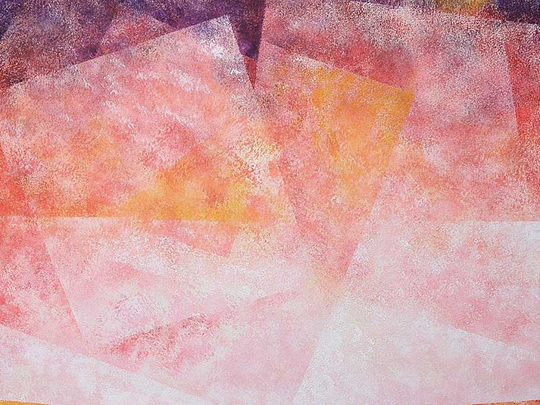
Kamal Boulatta’s abstract works as a painter and printmaker are inspired by his in-depth research of Islamic art and culture, and his love for music. The Berlin-based Palestinian artist has written several books based on his pioneering studies on Palestinian art and done extensive research on Islamic art in Morocco and Spain. His writings on classical and Arab art and culture have been published in various publications and academic journals and translated into various languages.
His latest exhibition in Dubai, Addolcendo, presents two different facets of his work. The recent Addolcendo series of small watercolour, gouache and crayon paintings on paper was created spontaneously without any sketch or theme in mind. Also on display are silk screen prints from his Quartet and Granada Portfolio series, created in the 1990s. These are based on his research and analysis of the mathematical Fibonacci series and the art and architecture of the Alhambra palace in Spain and executed with deliberate and precise calculations and planning.
Palestinian artist Kamal Boullata’s recent series of small watercolour, gouache and crayon paintings on paper was created spontaneously without any sketch or theme in mind
“This exhibition shows two sides of who I am — the adult and the child. While each line, colour and stroke in the silk screen prints has been carefully thought out, the watercolour paintings are simply about playing like a child with colours and forms,” Boulatta says.
Painting the Addolcendo series felt like play to him because he has used the porchoir technique to create it. This technique was originally used in the early 20th century in Paris to make limited editions of prints; but Boulatta has adapted it as a method for painting, using stencils of different shapes and sizes to apply the paint on the paper. The soft colours thus flow on the paper mixing gently to form layers of near transparent colour fields. The artist has then used crayons and gouache applied with a round flat brush to create diagonal lines, geometric shapes and interesting textures resulting in lyrical, abstract compositions that are infused with light, softness and rhythm.
“I used porchoir because I wanted to fill up space without using a brush so that I would have the air of the colour and a lightness and gentleness in the works, like capturing a fragrance wafting through the air. I always listen to music while painting and I felt that if my earlier work is like classical music with a precise structure, this series is like improvised music. Addolcendo is an Italian term meaning gentle or sweet and it was first used in the classical period to describe the softening and gradually becoming quieter tone of a musical passage. It also refers to the slight difference that a performer might introduce in a composer’s work to sweeten a tone. It is an apt title for this series, which is about gentleness and sweetness and coming close to look at the intimate works. In response to the current madness and darkness around us, I wanted a return to gentleness and something beautiful that will be left after the war to remind us that there is a spiritual space inside us where we can still imbibe beauty, lightness, freedom and peace,” Boulatta says.
The artist’s Granada Portfolio, from 1995 also features lyrical, abstract works but the lines are sharp and precise and the colours bright and distinct. The project was a collaboration with Syrian poet, and long-time friend Adonis, where the artist created a series of twelve sketches inspired by Alhambra to which Adonis responded with the poem Twelve Lanterns of Granada.
The poems were then printed in two books in accordion format, which resembled the interplay of poetry and architecture in Granada’s famous Alhambra. While the poet drew his inspiration from the calligraphic fragments on the wall, Boullata played with the geometric principles, repetitive patterns and colours in the architecture and ceramic tiles of the palace.
“My research indicated that the diagonal angle in most of the arabesque patterns of Alhambra’s tiles have been based not on the common forty-five-degree angle of the diagonal dissecting a square, but rather on a sixty-five-degree angle that is produced after the square unit is vertically dissected in two halves. That was the angle I used in composing the diagonal angle in my square prints,” Boulatta says.
Each composition was carefully printed as a silkscreen, ensuring that the lines were straight and the colours did not smear or overlap. Reflecting the flowing streams in Al Hambra, the twelve prints are divided into four triptychs, each named after one of the four rivers that were believed to flow in Paradise.
Addolcendo will run at Meem Gallery, Dubai, until February 20













